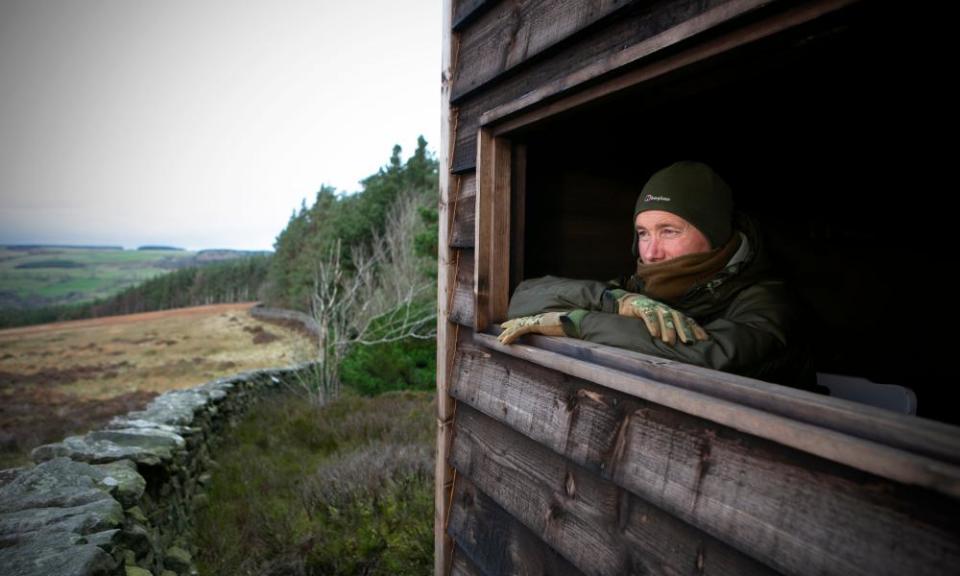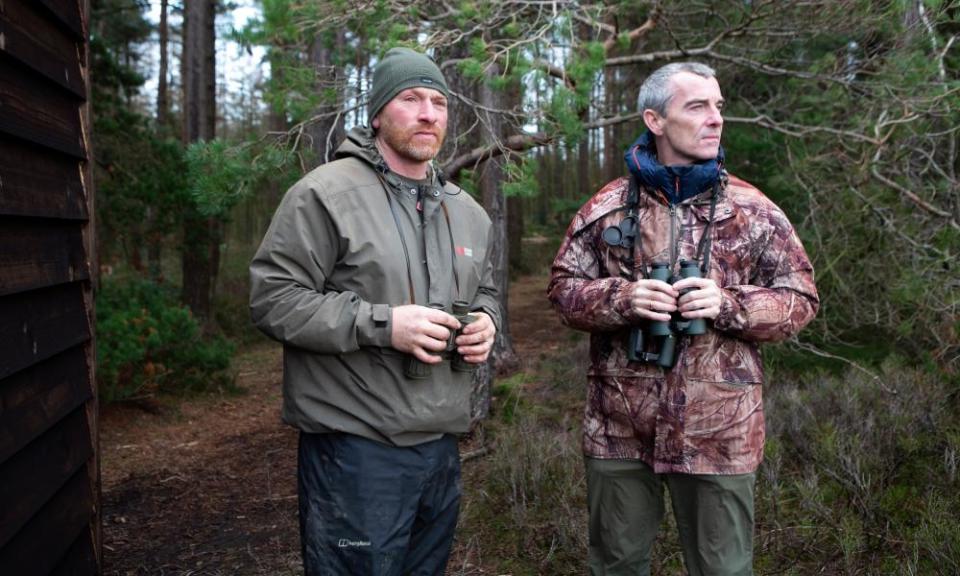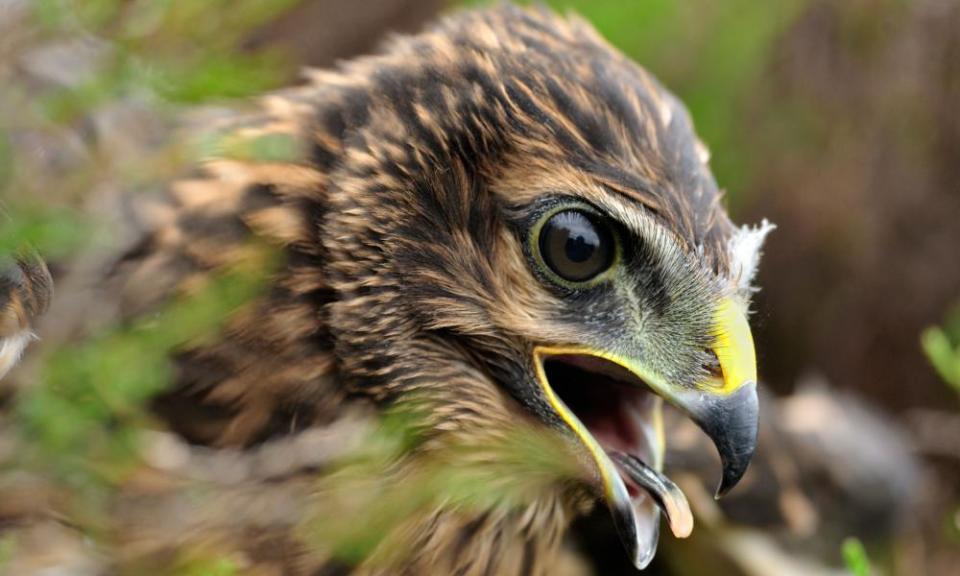Hen harriers’ friend: gamekeeping turns conservation in Yorkshire

In the trees beside the heather-clad, snow-smattered moorland is an elusive creature that to some conservationists is as mythical as a unicorn: a gamekeeper looking after endangered birds of prey.
“Two hen harriers coming in now,” said Gary Taylor, head keeper on the Swinton estate in North Yorkshire. Taylor is sitting in a hide he built himself overlooking one of the country’s best hen harrier roosting sites – in the middle of his boss’s grouse moor.
The hen harrier is one of Britain’s most endangered birds because of illegal persecution. England has upland habitat suitable for more than 300 breeding pairs of hen harriers but in 2013 there were none. The raptors take red grouse and conservationists accuse the grouse moor industry of killing hen harriers.

But the hen harrier’s prospects are brightening. This year, 24 successful hen harrier nests in England fledged 84 chicks, the highest number since records began in 2002. Nineteen of those nests were on grouse moors.
Taylor’s efforts to prove that hen harriers can thrive alongside driven grouse shooting are lauded by Stephen Murphy, one of the country’s top hen harrier experts.
“What he’s done for harriers, words can’t describe,” said Murphy, Natural England’s lead adviser for hen harriers, whose studies of satellite-tagged hen harriers showed that illegal persecution was responsible for their low numbers.
Since 2019, hen harrier nests on the 8,000 hectare (20,000-acre) estate have produced 23 successful fledglings, with Taylor and his wife placing fresh mice on a feeding post for a male harrier, a tagged bird known as Frank. This “diversionary feeding” helps harriers and reduces their predation of red grouse in breeding season.
Meanwhile, Taylor’s control of predators such as crows, foxes, stoats and weasels to protect ground-nesting red grouse also assists the ground-nesting hen harriers.
In winter, up to 16 hen harriers roost on the moor and Taylor’s hide overlooking the roost is open to the public. Next year, the estate plans to put a camera beside a harrier nest to beam live pictures to a local pub.
“What’s here is almost optimum conditions for hen harriers to breed well,” said Murphy, whose phone tells him there are currently four of England’s 28 satellite-tagged harriers on this one estate.
This turnaround for hen harriers is in North Yorkshire – a hotspot for illegal persecution – and on an estate where two satellite-tagged birds were found shot: Betty in 2012 and River in 2019.

Murphy first met Taylor when they searched together for Betty. Murphy said Betty had been shot away from the estate before flying on to it. In both cases the Swinton estate was not accused of or charged with any offence and emphatically rejects any suggestion of wrongdoing.
There were 137 confirmed raptor persecution incidents detected in Britain in 2020, the highest ever recorded by the RSPB. Of these, 34% were connected with pheasant or partridge shooting and 28% connected with grouse.
According to Murphy, evidence that illegal persecution is lessening on grouse moors is not breeding success (which can be due to a good year for voles, a favourite prey) but the survival of long-lived satellite-tagged birds, such as Sorrel (born 2016) and Dru (born 2017). “What’s incontrovertible is that we’ve got 8 to 10 wild birds breeding on English grouse moors and staying there in winter,” he said.
Support for hen harriers from grouse shooting estates is still criticised by many conservationists because it is part of the government’s controversial five-year “brood management” trial.
Hen harriers like to nest close to each other, and so a concentration of nests can build up on grouse moors. If a second nest appears near a first, brood management allows landowners to apply to remove chicks, which are reared in captivity and released. This gives grouse operations a “safety valve” so hen harrier populations won’t become so concentrated that grouse numbers decline.

The costs of captive-rearing are met by landowners. One nest close to Swinton’s boundary was reared in captivity this year. Nationally, six of eight captive-bred chicks from 2020 survived in the wild this year, a higher survival rate than wild-reared chicks.
Katie-Jo Luxton, the RSPB’s director of conservation, said the first step to hen harrier recovery should be the end of illegal persecution.
“If brood management is successful and there are more hen harriers, ‘to manage’ it would involve an ever-increasing level of intervention as the perceived conflict with grouse shooting increases,” she said. “Brood management is about forcing hen harriers to fit in with driven grouse shooting. That’s starting in entirely the wrong place. Driven grouse shooting should instead fit around the recovery of hen harriers. And if it can’t, it needs to change.”
Mark Cunliffe-Lister, Lord Swinton and chair of the Moorland Association, said he and other moor owners hope to show it’s possible to have a sustainable driven grouse shoot and breeding hen harriers – which could also boost eco-tourism. “We haven’t got there yet but I’m still confident we’re going to get there,” he said.
Since 1861, Swinton’s average season produces 5,000 shot grouse; this year it’s barely 500. Cunliffe-Lister and Taylor say that is not because of hen harriers, but due to heather on which grouse feed being destroyed by a pest beetle. A cold wet spring also reduced grouse-breeding success.
Taylor is convinced that hen harriers, grouse and people can all prosper. “Hen harriers are part and parcel of what’s on the moor,” he said. “Grouse shooting gets a bad press but it’s responsible for the biggest part of upland conservation. Maintaining habitat and controlling predators benefits so many wild species, not just gamebirds.”

 Yahoo Finance
Yahoo Finance 